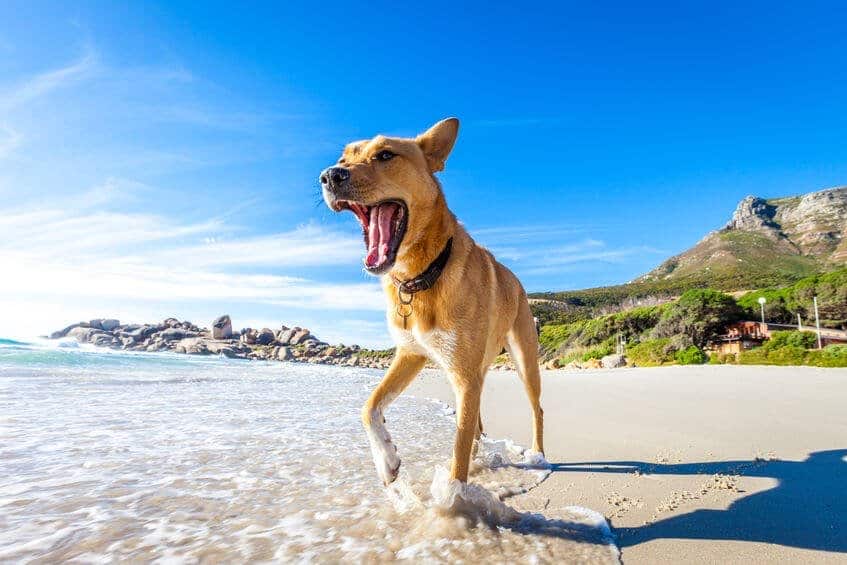This time of year, it’s really important to pay attention to summer safety tips for pets.
As the sun beats down during the summer months, your dog’s health can take a bad turn quickly if you’re not careful. Hot weather can result in dehydration, heat exhaustion, heat stroke, and other problems that can be disastrous for your pet.
But even though the dangers are real, that doesn’t mean you can’t get outside with your pet and have fun during the summer. If you just follow a few common-sense precautions, you can have a great time with your furry family member. Just remember to keep these considerations in mind when you take your pet to the dog park, the beach, or anywhere else.
Top Summer Safety Tips For Pets That Every Dog Parent Should Know
The last thing you want your dog to experience during a summer outing is heat stress. Certain types of animals are more prone to heatstroke and other problems associated with hot weather.

Here are a few other tips to help keep your dog safe when the heat is on.
- A dog with any sort of lung or heart problem, an older dog, or an overweight dog, should stay inside.
- Never assume your dog can swim. Not all breeds are good at it. Always watch your pet whenever they’re around a pool. If your pet can swim, remember to wash off their fur when they get out of the pool. Chlorine may irritate their skin.
- Try not to leave any windows open in your home. Your pet may fall through and not be able to get back inside.2
Pets, Parked Cars, And Hot Weather Don’t Mix: Never Leave Your Pet In A Hot Car
It almost never fails. Each summer, you hear horrific stories of pets and small children locked inside a vehicle on a hot day. In far too many instances, the outcomes are tragic. What makes these deaths even more tragic is that they were completely preventable. You can’t simply crack a window and assume your pet will be fine. Never leave a pet in a hot car. Just don’t do it. Please.

But what do you do if you notice a child or a pet who has been locked inside a baking hot vehicle? Your first inclination may be to shatter the window, open the door, and let them out. Be careful before you take this sort of action. It’s possible you could be in legal trouble, depending on the state in which you live.
While you’re thinking of it, check your state’s laws to see what they say. That way, you’ll know where you stand should you ever have to do something to save a suffering pet. Call 911 first if you think a pet or child is in danger.
Heat Stroke: How To Save Your Dog From Extreme Heat Stress
Heatstroke is one of the most dangerous risks associated with summer. A dog has a normal body temperature of between 100°-103°F. A cat’s normal temperature is between 100.4°-102.5°F. If their temperature gets any higher, heat stroke may occur.4

- Unsteadiness on their feet
- Vomiting
- Excessive panting
- Thick drool
- Gums that are bright red or darker than normal
- Diarrhea5
If you notice any of these signs, get your pet out of the heat immediately. Put a wet towel over them. Don’t use cold water (which could cause shock). Instead, wet the towel with lukewarm or cool water to help cool down their body. Then, get to the vet.6
Is Your Furry Friend Having Excessive Thirst? Make Sure To Provide Extra Hydration
Dehydration is one of the biggest threats during the summer for humans and pets. Knowing the signs that your pet might be becoming dehydrated allows you to take steps to make sure it doesn’t become a serious problem.
One of the most common indications of dehydration is a lack of elasticity in the skin. If you suspect your dog is dehydrated, gently hold some of the skin near their shoulders. Raise the skin up and then let it fall. If your dog is not dehydrated, the skin will instantly snap back into place. If the dog is dehydrated, it will take a good deal longer.7
Here are a few other potential signs of dehydration in dogs.
- Dry-looking eyes that may appear sunken
- Saliva that is thicker than normal
- Appetite loss
- Lethargy
- Excessive panting
- Vomiting and/or diarrhea
- Dry nose
- Dry gums8
Avoid The Hot Pavement, And Don’t Let Your Dog’s Paw Pads Linger There
It’s important for your dog to get exercise, no matter what time of the year it may be. But you also don’t want your evening walk to be a painful experience for your pet. If you’re a pet parent, the last thing you want to do is to injure your dog’s paws by walking them on a hot sidewalk.

Fortunately, there are a couple of easy ways to protect your pet’s paws. One is known as the “seven-second rule.” Go outside alone, and put the back of your hand on the sidewalk. If you can’t keep it there that long, then the pavement is too hot for your pet.10 Try walking with your dog early in the morning, or bring a flashlight and walk after sunset if possible.
The precautions you take will be well worth it, especially when you consider the consequences. A dog with burned paws may need expensive medications, and they may not be able to walk. But if you’re careful, you shouldn’t ever have to worry about this happening to your pet.
Have Fun But Be Careful
Again, there’s no reason why your pet can’t enjoy the great outdoors during the summer. Go ahead and take them to the lake, the beach, or let them run around merrily in the backyard. Just remember to take a few simple safety precautions to make sure your pet is not only having fun, but is also safe while doing so. Hopefully, these summer safety tips for dogs will mean weeks of summer fun for you both.
Learn More:
How To Tell If Your Dog Is Happy And Healthy: Info For Pet Parents
Learn How To Give Mental Stimulation For Dogs
Pet Guides: Safety In The Home For Your Furry Friends
Sources
1 https://www.aspca.org/pet-care/general-pet-care/hot-weather-safety-tips
2 https://www.aspca.org/pet-care/general-pet-care/hot-weather-safety-tips
3 https://petcube.com/blog/the-dog-days-of-summer-leaving-pets-in-cars
4 https://petcube.com/blog/pet-summer-safety/
5 https://petcube.com/blog/pet-summer-safety/
6 https://www.akcchf.org/canine-health/your-dogs-health/caring-for-your-dog/heat-stroke-and-heat-exhaustion.html
7 https://www.akc.org/expert-advice/health/warning-signs-dehydration-dogs
8 https://www.akc.org/expert-advice/health/warning-signs-dehydration-dogs
9 https://www.vets-now.com/2017/06/never-walk-dogs-hot-asphalt-tarmac-pavements-artificial-grass/
10 https://www.vets-now.com/2017/06/never-walk-dogs-hot-asphalt-tarmac-pavements-artificial-grass/
Get our best articles straight to your inbox.
Subscribe to The DARling below:
About the author



